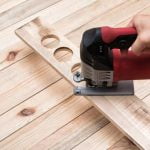Why do dogs chew woodwork? This article delves into the reasons behind this common behavior among our canine companions. Dogs have a natural instinct to chew, but when this behavior is directed towards woodwork in our homes, it can become problematic. Understanding why dogs engage in this behavior and its impact on their health is crucial for pet owners to address and correct it effectively.
Chewing is a normal behavior for dogs, providing mental and physical stimulation while helping with dental hygiene. However, when dogs start chewing on woodwork such as furniture, baseboards, or door frames, it can cause damage to our homes and pose risks to their well-being. From teething puppies seeking relief to adult dogs dealing with anxiety or boredom, there are various reasons why dogs may target woodwork for chewing.
As pet owners, it is essential to recognize the underlying causes of woodwork chewing in dogs and take proactive measures to prevent this behavior. By understanding why dogs chew woodwork and implementing appropriate training techniques and providing suitable alternatives for them to redirect their chewing habits onto safer options, we can help our furry friends lead healthier and happier lives.
Understanding the Natural Instinct of Dogs to Chew
Dogs are known for their natural instinct to chew on things, including woodwork in our homes. But why do dogs chew woodwork? One of the main reasons is that chewing helps to relieve boredom, anxiety, and even teething discomfort in puppies. Just like humans, chewing can be a stress-reliever for dogs and a way for them to occupy themselves when they are feeling restless or anxious.
Another reason why dogs chew woodwork is to fulfill their innate need to explore and interact with their environment. Dogs use their mouths to learn about the world around them, and exploring different textures through chewing is a part of that process. Chewing on woodwork may also provide some oral stimulation for dogs, especially if they don’t have access to appropriate chew toys or bones.
In some cases, dogs may resort to chewing woodwork out of frustration or lack of physical exercise. If a dog is not getting enough mental and physical stimulation, they may turn to destructive behaviors like chewing as a way to release pent-up energy.
It’s important for dog owners to recognize the underlying reasons behind their dog’s wood-chewing habit in order to address it effectively and prevent any potential harm to the dog or damage to the home.
| Reasons Why Dogs Chew Woodwork | Explanation |
|---|---|
| Boredom/anxiety | Chewing helps relieve stress and provides an outlet for restless energy. |
| Natural exploration | Dogs use their mouths to learn about their surroundings and textures. |
| Frustration/lack of exercise | Dogs may chew out of frustration or due to insufficient physical activity. |
Common Reasons Why Dogs Chew Woodwork
Teething and Oral Stimulation
One common reason why dogs chew on woodwork is due to teething. Just like human babies, puppies go through a teething phase where their gums are sore and they feel the need to chew to alleviate the discomfort. Chewing provides them with relief and helps in loosening baby teeth for adult teeth to come in. In addition to teething, dogs also chew on woodwork as a way to satisfy their natural urge for oral stimulation.
Anxiety and Stress
Another reason why dogs may resort to chewing on woodwork is due to anxiety or stress. Dogs, especially those prone to separation anxiety, may chew as a way of coping with feelings of loneliness when left alone. Stressful situations such as changes in routine, new environments, or loud noises can also trigger a dog to engage in destructive chewing behavior. By gnawing on woodwork, dogs can release pent-up energy and frustration.
Boredom and Lack of Exercise
Dogs are highly energetic animals that require mental stimulation and physical exercise to stay healthy and happy. When dogs are bored or not getting enough exercise, they may turn to chewing on woodwork as a way to occupy themselves.
Lack of mental enrichment and physical activity can lead dogs to look for alternative ways to keep themselves entertained, which could result in destructive behaviors like chewing furniture. Engaging your dog in interactive toys, puzzle games, regular walks, and playtime can help redirect their focus away from woodwork chewing.
Impact of Chewing Woodwork on a Dog’s Health
Chewing is a natural behavior for dogs, providing them with mental stimulation, alleviating anxiety, and helping maintain healthy teeth and gums. However, when dogs turn to woodwork as their chewing outlet, there can be serious implications for their health. Woodwork may contain toxic substances such as paint or varnish, which can be harmful if ingested by dogs. Additionally, splinters from chewed wood can cause internal injuries or blockages in the digestive tract.
One of the main reasons why dogs chew on woodwork is due to boredom or lack of attention. Dogs may engage in destructive chewing behaviors when they are not properly exercised or mentally stimulated. In some cases, anxiety or stress can also drive dogs to chew on woodwork as a coping mechanism. It is important for dog owners to address the root cause of their dog’s behavior in order to prevent any negative impact on their health.
Another reason why dogs chew on woodwork is due to teething in puppies. Just like human babies, puppies go through a teething phase where they have an urge to chew on objects to relieve gum discomfort.
Providing appropriate chew toys and teething aids can help redirect this behavior and protect both the puppy and your furniture. It’s essential for dog owners to understand these reasons behind their dog’s wood-chewing habit in order to effectively address it and ensure their furry friend’s well-being.
Tips to Prevent Dogs From Chewing Woodwork
Provide Appropriate Chew Toys
One of the most effective ways to prevent dogs from chewing woodwork is to provide them with appropriate chew toys. Dogs have a natural instinct to chew, so giving them designated items to satisfy this behavior can help steer them away from your furniture and trim. Look for durable and safe chew toys that are specifically designed for dogs, taking into consideration their size and chewing habits.
Supervise and Redirect
When you notice your dog attempting to chew on woodwork, it is essential to intervene immediately. Supervise your dog closely, especially in areas where woodwork is accessible. If you catch them in the act, calmly redirect their attention towards an acceptable chew toy or engage them in a different activity. Consistent redirection will help reinforce positive chewing behaviors and discourage destructive habits.
Implement Positive Reinforcement
Positive reinforcement is a powerful tool when training dogs not to chew on woodwork. Whenever your dog chooses to chew on their toys instead of furniture or trim, reward them with praise, treats, or playtime. Positive reinforcement helps reinforce good behavior and can encourage your dog to continue making the right choices. Remember to be patient and consistent in your training efforts as breaking a habit takes time and effort.
Replacement Behaviors to Redirect a Dog’s Chewing Habit
Dogs have a natural instinct to chew, which can sometimes lead them to target woodwork in our homes. Understanding why dogs chew woodwork is crucial in order to address and correct this behavior effectively. There are several common reasons why dogs engage in this behavior, including teething, boredom, anxiety, and the need for mental stimulation.
To prevent dogs from chewing woodwork, owners can take proactive measures such as providing appropriate toys and chews, ensuring regular exercise and playtime, as well as creating a safe and stimulating environment for their pets. It is important to remember that simply scolding or punishing a dog for chewing woodwork is not an effective solution. Instead, replacement behaviors can be implemented to redirect the dog’s chewing habit onto more appropriate items.
Here are some replacement behaviors to redirect a dog’s chewing habit:
- Provide durable chew toys specifically designed for dogs
- Use puzzle feeders or interactive toys to stimulate mental activity
- Engage in positive reinforcement training techniques when the dog chews on acceptable items
By implementing these replacement behaviors and consistently reinforcing good behavior, pet owners can help their dogs develop healthier chewing habits and avoid potential dangers associated with ingesting wood or other harmful materials. Training a dog to stop chewing woodwork may take time and patience, but with dedication and consistency, this behavior can be successfully corrected.
Potential Dangers of Allowing Dogs to Continue Chewing Woodwork
Dogs chewing on woodwork may seem like a harmless behavior, but allowing them to continue can pose potential dangers to both your pet and your home. One of the primary risks associated with this habit is the ingestion of splinters or small wood fragments, which can lead to gastrointestinal issues such as blockages or perforations. These injuries can be painful for your furry friend and may require surgery to correct.
Furthermore, repeated chewing on woodwork can damage your furniture, walls, and other surfaces in your home. Not only does this result in costly repairs or replacements, but it can also create safety hazards if the structural integrity of these items is compromised. Additionally, the chemicals used in treating or finishing woodwork could be toxic if ingested by your dog, leading to poisoning and potentially fatal consequences.
To prevent these potential dangers from materializing, it is crucial to address and correct your dog’s wood-chewing behavior promptly. By understanding the root causes behind this habit and implementing strategies to redirect their focus onto appropriate chew toys or activities, you can safeguard both your pet’s well-being and the longevity of your home furnishings.
| Potential Dangers | Impact |
|---|---|
| Ingestion of splinters | Gastrointestinal issues |
| Damage to furniture and surfaces | Safety hazards and costly repairs |
| Toxicity from woodwork chemicals | Poisoning and fatal consequences |
How to Train a Dog to Stop Chewing Woodwork
Dogs chewing on woodwork can be a frustrating behavior for pet owners to deal with. Understanding the reasons behind this behavior is crucial in addressing and correcting it effectively. While it may seem harmless, excessive chewing on woodwork can have negative consequences, both for the dog and the household. Here are some tips on how to train a dog to stop chewing woodwork:
- Provide appropriate chew toys: One of the main reasons dogs chew on woodwork is because they are seeking something to satisfy their natural urge to chew. By providing them with appropriate chew toys, such as rubber bones or Kong toys, you can redirect their chewing behavior onto more suitable objects.
- Supervise your dog: Keeping a close eye on your dog when they are indoors can help prevent them from accessing woodwork they shouldn’t be chewing on. If you notice your dog starting to chew on furniture or door frames, immediately intervene and redirect their attention to an approved chew toy.
- Use deterrents: There are various commercial sprays available that have bitter or unpleasant tastes, which can be sprayed onto woodwork to discourage dogs from chewing on them. Additionally, you can try rubbing citrus fruits or vinegar onto the surfaces as a natural deterrent.
It’s important to remember that training takes time and consistency. Reinforce positive behaviors with rewards such as treats or praise when your dog chooses the appropriate chew toy over the woodwork. With patience and persistence, you can help your dog break the habit of chewing on woodwork and create a safe environment for both your pet and your home.
Conclusion
In conclusion, understanding the reasons behind why dogs chew woodwork is essential in addressing and correcting this behavior. Dogs have a natural instinct to chew, which can be influenced by factors such as boredom, anxiety, teething, or simply seeking attention. However, allowing this behavior to persist can have negative impacts on a dog’s health, including potential dental issues, digestive problems from ingesting wood splinters, and even choking hazards.
To prevent dogs from chewing woodwork, it’s important to provide them with appropriate chew toys and outlets for their chewing needs. Additionally, training and redirecting their focus towards replacement behaviors can help eliminate the urge to chew on furniture or other household items. Consistency and patience are key in training a dog to stop this destructive habit.
Ultimately, taking proactive measures to address and correct woodwork chewing behavior in dogs not only preserves your belongings but also ensures the well-being of your furry companion. By understanding their instincts and providing the necessary tools for redirection, you can build a stronger bond with your pet while promoting their overall health and happiness. Remember that prevention is key in maintaining a harmonious living environment for both you and your beloved canine friend.
Frequently Asked Questions
Why Do Dogs Chew on Wood Trim?
Dogs may chew on wood trim due to various reasons such as boredom, teething, stress, or simply out of habit. Chewing can also be a way for dogs to relieve anxiety or discomfort.
What Can I Use to Stop My Dog From Chewing on Wood?
To prevent your dog from chewing on wood trim, you can provide appropriate chew toys, increase exercise and mental stimulation, use deterrent sprays or taste aversions, supervise them closely, and redirect their behavior when caught in the act.
Is It OK for Dogs to Chew and Eat Wood?
While it’s common for dogs to chew on wood, especially during certain life stages like teething, it is not safe for them to consume wood. Ingesting wood pieces can lead to digestive issues, obstructions, splinters causing injuries in the mouth or throat, and potential toxicity if treated or coated with chemicals.

Hi everyone! I’m a woodworker and blogger, and this is my woodworking blog. In my blog, I share tips and tricks for woodworkers of all skill levels, as well as project ideas that you can try yourself.





